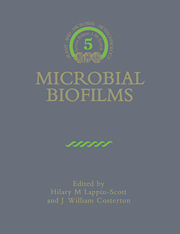Book contents
- Frontmatter
- Contents
- List of Contributors
- Series Preface
- Introduction to Microbial Biofilms
- Part I Structure, Physiology and Ecology of Biofilms
- 1 Growth of Microorganisms on Surfaces
- 2 Dynamics of Bacterial Biofilm Formation
- 3 Cultivation and Study of Biofilm Communities
- 4 Genetic Responses of Bacteria at Surfaces
- 5 Biochemical Reactions and the Establishment of Gradients within Biofilms
- 6 Mechanisms of the Protection of Bacterial Biofilms from Antimicrobial Agents
- Part II Biofilms and Inert Surfaces
- Part III Biofilms on the Surfaces of Living Cells
- Index
4 - Genetic Responses of Bacteria at Surfaces
Published online by Cambridge University Press: 24 November 2009
- Frontmatter
- Contents
- List of Contributors
- Series Preface
- Introduction to Microbial Biofilms
- Part I Structure, Physiology and Ecology of Biofilms
- 1 Growth of Microorganisms on Surfaces
- 2 Dynamics of Bacterial Biofilm Formation
- 3 Cultivation and Study of Biofilm Communities
- 4 Genetic Responses of Bacteria at Surfaces
- 5 Biochemical Reactions and the Establishment of Gradients within Biofilms
- 6 Mechanisms of the Protection of Bacterial Biofilms from Antimicrobial Agents
- Part II Biofilms and Inert Surfaces
- Part III Biofilms on the Surfaces of Living Cells
- Index
Summary
Introduction
The majority of studies on biofilms are concerned with the formation and structure of biofilms (see Korber et al., Chapter 1), the direct effects of microbial activities on surfaces, such as in metal corrosion (see Hamilton, Chapter 9), dental caries (see Marsh, Chapter 18) tissue invasion, or indirect effects of biofilms on fluid frictional resistance, heat exchange across metal surfaces, substrate transformations and biocide resistance of the biofilm organisms on biomaterials implanted in human patients (see McLean et al., Chapter 16) and on water distribution pipeline surfaces (Characklis & Marshall 1990; Anwar et al. 1992). Extensive reviews have dealt with the activities of microorganisms at surfaces (Marshall 1971; Stotzky 1986; van Loosdrecht et al. 1990; Fletcher 1991), but little on the actual genetic responses of microorganisms at surfaces. The aim of this chapter is to consider the environmental conditions existing at gel–air and solid–water interfaces, as well as in biofilms, and to relate these conditions to possible genetic responses in the immobilized bacteria.
Properties of surfaces
Bacteria at surfaces or, more broadly, at interfaces are exposed to environmental conditions not found in an aqueous phase. An interface is defined, in physicochemical terms, as the boundary between two phases in a heterogeneous system. The most common interfaces to which bacteria are exposed in nature and under laboratory conditions are solid–water interfaces (stones, soil particles, ship hulls, pipeline surfaces, glass and plastic culture vessels), although air–water (surface of bodies of water, bubbles), oil–water (oil spills) and solid–air (intertidal zones, agar surfaces) interfaces also are encountered. The concept of bacterial behaviour at various interfaces has been treated in detail by Marshall (1976).
- Type
- Chapter
- Information
- Microbial Biofilms , pp. 80 - 98Publisher: Cambridge University PressPrint publication year: 1995
- 28
- Cited by

